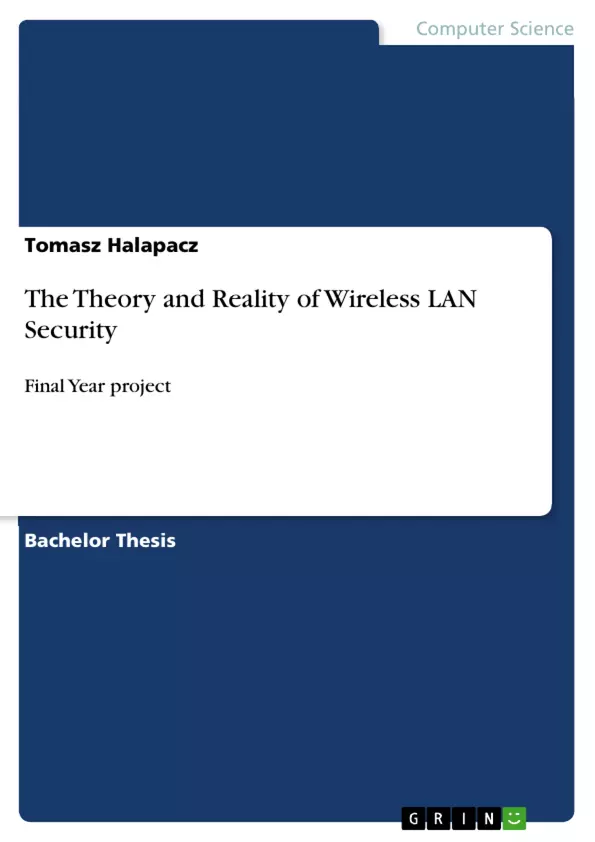This paper addresses the theory and reality of Wireless LAN security. It provides an overview of security mechanisms and explains how security works in Wireless LAN networks. An in depth analysis of the Wired Equivalent Privacy (WEP), Wi-Fi protected access (WPA) and WPA2 standards is presented. The security vulnerabilities that exist in them are analysed and explained. In the investigation, a wardriving approach is used. It is observed that about 30% of all WLANs detected during network discovery experiment operate with WEP encryption witch further investigated is proved that can be compromised with 100% success. The author discusses the potential consequences that arise from using a weak encryption. Experimental results of penetrating WPA secured network illustrate how easy it is to protect from dictionary attacks by simply using a combination of strong encryption protocol and complex key. The results of the practical part of the project are used to generate guideline in terms of choosing the right encryption method.
Table of Contents
-
- AIM AND OBJECTIVES
- Aim
- Objectives
- LITERATURE REVIEW
- WIRELESS LOCAL AREA NETWORK
- Wireless LAN Security
- WEP-WIRED EQUIVALENT PRIVACY
- WEP Security Analysis
- How WEP works
- Conclusion
- WPA/WPA2 - WI-FI PROTECTED ACCESS
- WPA/WPA2 Security Analysis
- How WPA works
- How WPA2 works
- Conclusion
- SSID - SERVICE SET IDENTIFIER
- MAC FILTERING
- VPN - VIRTUAL PRIVATE NETWORKS
- WIRELESS LAN ATTACKS
- Passive Attacks
- Replay Attack
- Eavesdropping
- Brute force attacks
- Statistical attacks
- Active Attacks
- Denial of Service
- Man in the Middle
- METHODOLOGY
- RESEARCH METHODOLOGY
- EXPERIMENTAL METHODOLOGY
- PLANNING AND MONITORING
- RISK ASSSESMENT
- CONCLUSION
- WIRELESS NETWORK SECURITY SURVEY: WARDRIVE
- INTRODUCTION
- METHODOLOGY
- FINDINGS
- RESULTS
- CONCLUSION
- WIRELESS LAN PENETRATION TESTS
- INTRODUCTION
- METHODOLOGY
- CRACKING WEP PASSWORD
- Results
- Conclusion
- CRACKING WPA PASSWORD
- Results
- Conclusion
- RECOMMENDATIONS
- PROJECT EVALUATION
- EVALUATION OF THE OBJECTIVES
- EVALUATION OF THE METHODOLOGY
- REFLECTION
- REFERENCES
- Wireless LAN security mechanisms
- Vulnerabilities in WEP, WPA, and WPA2 standards
- Practical wardriving and penetration testing methodologies
- Recommendations for securing Wireless LAN networks
- Analysis of security threats and potential consequences
- Chapter 1: Introduces the aim and objectives of the paper, focusing on providing a comprehensive understanding of Wireless LAN security.
- Chapter 2: Presents a literature review of Wireless LAN security, discussing various security mechanisms like WEP, WPA, WPA2, SSID, MAC filtering, VPN, and common wireless LAN attacks.
- Chapter 3: Outlines the research and experimental methodologies used in the paper, including a detailed explanation of planning, monitoring, and risk assessment.
- Chapter 4: Presents the results of a wireless network security survey conducted using wardriving techniques, discussing findings and analysis of the data collected.
- Chapter 5: Details the methodology and results of penetration testing experiments conducted to crack WEP and WPA passwords, providing insights into the effectiveness of different security protocols and password strengths.
- Chapter 6: Provides recommendations based on the findings and analysis of the research, offering practical guidelines for securing Wireless LAN networks.
- Chapter 7: Evaluates the objectives and methodology of the project, reflecting on the overall effectiveness of the research and its impact.
Objectives and Key Themes
This paper investigates the theoretical and practical aspects of Wireless LAN security. It aims to provide a comprehensive understanding of security mechanisms in Wireless LAN networks. The paper analyzes the effectiveness and vulnerabilities of different security standards like WEP, WPA, and WPA2. Key themes include:Chapter Summaries
Keywords
The key themes and concepts explored in this work include wireless LAN security, WEP, WPA, WPA2, wardriving, penetration testing, security vulnerabilities, and network security recommendations. The paper delves into the practical implementation of security measures and the effectiveness of various encryption protocols in securing wireless networks.- Citar trabajo
- Tomasz Halapacz (Autor), 2011, The Theory and Reality of Wireless LAN Security, Múnich, GRIN Verlag, https://www.grin.com/document/178977



